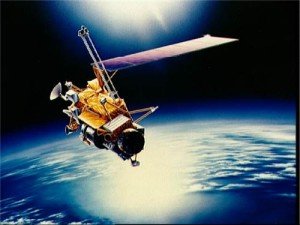Our friends at the Australian Science Media Centre have collected useful background, resources and commentary ahead of the re-entry:
 NASA’s Upper Atmosphere Research Satellite (UARS) is expected to return to Earth tomorrow morning (Saturday 24 September) Australian time. Its exact re-entry time and location will be known with more certainty closer to its landing. The ground tracks (the satellite’s “flight” path) during the re-entry period include several passes over Australia and there is a small chance that debris from the satellite could land in Australia.
NASA’s Upper Atmosphere Research Satellite (UARS) is expected to return to Earth tomorrow morning (Saturday 24 September) Australian time. Its exact re-entry time and location will be known with more certainty closer to its landing. The ground tracks (the satellite’s “flight” path) during the re-entry period include several passes over Australia and there is a small chance that debris from the satellite could land in Australia.
UARS was launched on 12 September 1991 and decommissioned on 15 December 2005. Its total dry mass is about 5.5 tonnes, compared to SkyLab which was about 77 tonnes. Debris from SkyLab landed in Western Australia in 1979. UARS is one of the largest NASA satellites to plunge back to Earth uncontrolled in the last 30 years.
RESOURCES:
According to the Centre for Orbital and Re-entry Debris Studies (CORDS), the current expected re-entry time for the UARS satellite is 12.58pm NZT (00:58 UTC) ± 7 hours tomorrow (Saturday 24 September).
Updates on this timing including a map showing the satellites’ ground track during the 14 hour window of re-entry,can be found at Rentry News.
NASA have been providing semi-regular updates at their UARS site.
An authoritative source of tracking information including the current position of the UARS satellite (keep refreshing the page) can be found at Heavens-Above.
A conceptual image of the satellite can be found here (credit: NASA).
Some useful background information on spacecraft reentry can be found at Areo.org.
Grant Christie, Research Astronomer, Auckland StarDome Observatory, comments:
“What’s special about this one is its sheer size. Skylab was the last big one. Ultimately all satellites come down, even the International Space Station and the Hubble Space Telescope. Once they run out of gas to control them or malfunction, they will come down. It’s not a matter of not having shuttles to service them.
“How fast will it be going? Most people have seen satellites going across the night sky.It will be faster than that. At about 50 kilometres up it will begin to smoke. If you were lucky you might see it for tens of seconds.”
Jonathan Nally is a former editor of two space magazines and currently editor of the Australian Space News web site, SpaceInfo.com.au. He also appears regularly on Channel 9 and the ABC to discuss astronomical and spaceflight matters.
“Space junk comes in different shapes and sizes, and can poses two main kinds of threats — a threat to other spacecraft (unmanned and manned) through collisions, and threats to us down here on Earth.
“The satellite making news at the moment — the former Upper Atmospheric Research Satellite, and better characterised as a decommissioned or defunct satellite rather than space junk — falls into the second category.
“In 2005, NASA decommissioned UARS and intentionally placed it into an orbit a couple of hundred kilometres lower than its operational orbit. This was done to accelerate is eventual demise, and means it is re-entering the atmosphere 20 years earlier than it otherwise would have done.
“This was a very responsible thing to do. The longer a spacecraft stays in orbit, the more chance it has of being hit by other orbital debris, leading to a destructive breakup and therefore more bits of debris.
“UARS poses a negligible threat to life and property on Earth. Most of the satellite will burn up during re-entry, with perhaps as many as 26 stronger or harder small pieces surviving to reach the surface.
“But with the majority of Earth comprising oceans or uninhabited (or very sparsely inhabited) remote regions, the chances are overwhelming that any pieces of UARS that survive re-entry will fall harmlessly and never be seen again.
“Because the spacecraft is no longer powered, NASA has no control over where it comes down. It is thought to be tumbling gently as it makes its final orbits. Friction with the thin upper atmosphere is slowly lowering its orbit, bit by bit, until sometime in the next 24 hours it reaches a low enough point and sufficient air friction so that it can no longer maintain orbital velocity. At this point it will begin to burn up and streak across the sky like a huge fireball. It would be quite something to see, but chances are that no one will witness it.
“The other kind of space junk — bits of orbital debris that range from less than a millimetre wide up to entire spacecraft — is more of a worry. Space junk can damage or destroy an operational spacecraft, leading to loss of the asset and the service it provides.”
Dr Alice Gorman is a lecturer in the Department of Archaeology, specialising in space archaeology, at Flinders University in SA.
“The UARS satellite re-entry is very reminiscent of Skylab in 1979 – there is the same exaggeration of the hazard through the media, public anxiety as the advance warning allows for speculation, and a lack of understanding of what the risks actually are. Should it land in Australia, we might expect the same rush for souvenirs as we saw with Skylab, as anything that has been in space has a special meaning on Earth.”